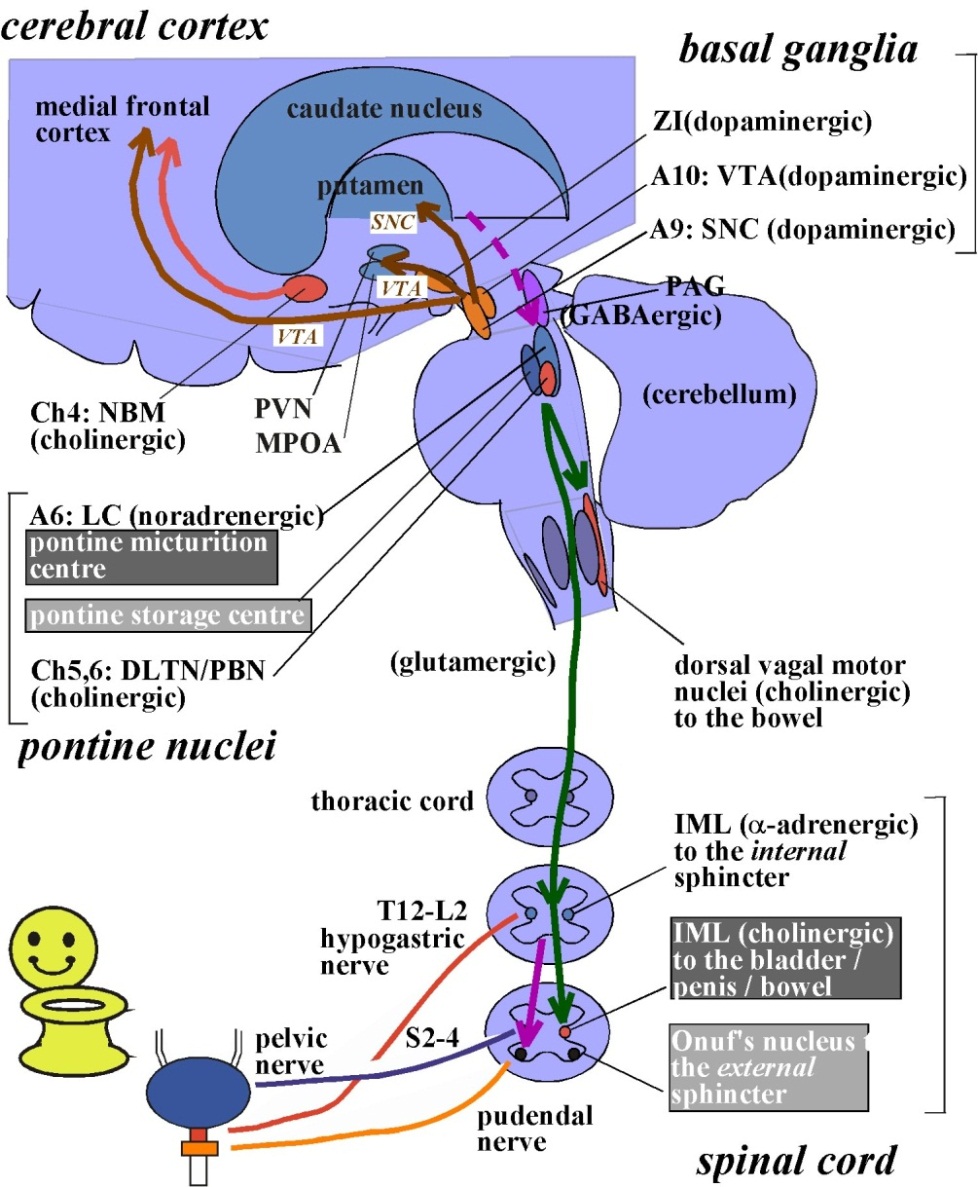Difference between revisions of "BrainRegionLAC PN PSYM PPG"
From aHuman Wiki
(Automated page entry using MWPush.pl) |
(Automated page entry using MWPush.pl) |
||
| Line 31: | Line 31: | ||
{| class=wikitable width=80% | {| class=wikitable width=80% | ||
| − | | '''Source Area''' || '''Source Region''' || '''Source Name''' || '''Type''' || '''Reference''' | + | | '''Source Area''' || '''Source Region''' || '''Source Name''' || '''Type''' || '''Role''' || '''Reference''' |
|- | |- | ||
| − | | [[BrainAreaLAC|LAC]] || [[BrainRegionLAC_SC_IZ_SPS|LAC.SC.IZ.SPS]] || Sacral Parasympathetic Nucleus || excitatory-glu || [http://jp.physoc.org/content/557/1/287/F9.expansion.html Schematic overview of spinobulbospinal micturition reflex pathway (SPS -> PEL)] | + | | [[BrainAreaLAC|LAC]] || [[BrainRegionLAC_SC_IZ_SPS|LAC.SC.IZ.SPS]] || Sacral Parasympathetic Nucleus || excitatory-glu || uncertain ||[http://jp.physoc.org/content/557/1/287/F9.expansion.html Schematic overview of spinobulbospinal micturition reflex pathway (SPS -> PEL)] |
|} | |} | ||
| Line 39: | Line 39: | ||
{| class=wikitable width=80% | {| class=wikitable width=80% | ||
| − | | '''Target Area''' || '''Target Region''' || '''Target Name''' || '''Type''' || '''Reference''' | + | | '''Target Area''' || '''Target Region''' || '''Target Name''' || '''Type''' || '''Role''' || '''Reference''' |
|- | |- | ||
| − | | [[BrainAreaTEA|TEA]] || [[BrainRegionTARGET_TEA_BREAST|TARGET.TEA.BREAST]] || Breast || nipple-smooth-muscles || (unknown reference) | + | | [[BrainAreaTEA|TEA]] || [[BrainRegionTARGET_TEA_BREAST|TARGET.TEA.BREAST]] || Breast || nipple-smooth-muscles || (none) || (unknown reference) |
|- | |- | ||
| − | | || [[BrainRegionTARGET_TEA_GENITALIA|TARGET.TEA.GENITALIA]] || Genitalia || corpus-cavernosum-clitoridis || (unknown reference) | + | | || [[BrainRegionTARGET_TEA_GENITALIA|TARGET.TEA.GENITALIA]] || Genitalia || corpus-cavernosum-clitoridis || (none) || (unknown reference) |
|- | |- | ||
| − | | || [[BrainRegionTARGET_TEA_RECTUM|TARGET.TEA.RECTUM]] || Rectum || sphincter-ani-internus-muscle-parasympathetic || (unknown reference) | + | | || [[BrainRegionTARGET_TEA_RECTUM|TARGET.TEA.RECTUM]] || Rectum || sphincter-ani-internus-muscle-parasympathetic || (none) || (unknown reference) |
|- | |- | ||
| − | | || [[BrainRegionTARGET_TEA_STOMACH|TARGET.TEA.STOMACH]] || Stomach || stomach-wall || (unknown reference) | + | | || [[BrainRegionTARGET_TEA_STOMACH|TARGET.TEA.STOMACH]] || Stomach || stomach-wall || (none) || (unknown reference) |
|- | |- | ||
| − | | || [[BrainRegionTARGET_TEA_URETER|TARGET.TEA.URETER]] || Ureter || detrusor-urinae-muscle-parasympathetic || (unknown reference) | + | | || [[BrainRegionTARGET_TEA_URETER|TARGET.TEA.URETER]] || Ureter || detrusor-urinae-muscle-parasympathetic || (none) || (unknown reference) |
|} | |} | ||
Latest revision as of 18:28, 28 April 2019
Pelvic Peripheral Ganglion
@@Home -> BiologicalLifeResearch -> BrainAreaLAC -> BrainRegionLAC_PN_PSYM_PPG
This page covers biological details of component Pelvic Peripheral Ganglion. Region is part of aHuman target integrated biological model.
- Top-down path to region: Peripheral Nervous System -> Parasympathetic Ganglia (PNS.PSYM) -> Body Parasympathetic Ganglia (PN.PSYM.BD) -> Pelvic Peripheral Ganglion (LAC.PN.PSYM.PPG) (see Mind Maps)
- Type: parasympathetic ganglion
- Quality: L0
- Brain area: Lower Brain - Autonomous Control Area (LAC)
- Area circuit: Sacral Autonomic Control (LAX)
- Role: parasympathetic.ganglion
- Function: Sigmoid, rectum, bladder, and external genitalia
- Notes to function:
- Pelvic nerve fibers
(generated)
Components
(generated)
- no child items defined
Connectivity
(generated)

Inbound Region Connections:
| Source Area | Source Region | Source Name | Type | Role | Reference |
| LAC | LAC.SC.IZ.SPS | Sacral Parasympathetic Nucleus | excitatory-glu | uncertain | Schematic overview of spinobulbospinal micturition reflex pathway (SPS -> PEL) |
Outbound Region Connections:
| Target Area | Target Region | Target Name | Type | Role | Reference |
| TEA | TARGET.TEA.BREAST | Breast | nipple-smooth-muscles | (none) | (unknown reference) |
| TARGET.TEA.GENITALIA | Genitalia | corpus-cavernosum-clitoridis | (none) | (unknown reference) | |
| TARGET.TEA.RECTUM | Rectum | sphincter-ani-internus-muscle-parasympathetic | (none) | (unknown reference) | |
| TARGET.TEA.STOMACH | Stomach | stomach-wall | (none) | (unknown reference) | |
| TARGET.TEA.URETER | Ureter | detrusor-urinae-muscle-parasympathetic | (none) | (unknown reference) |
Thirdparty Circuits
(generated)
- Physiology and pathophysiology of lower urinary tract - see Reference (CM.ONUF)
CN=Caudate Nucleus,FEC.FT.CN (see Basal Ganglia) DVM=Vagus Nucleus,LAC.HL.VGN IMG=Inferior Mesenteric Ganglion,LAC.PN.SYM.IMG IML=Intermediolateral Nucleus,LAC.SC.IZ.IML LC=Locus Coeruleus,LMC.HT.LC MPFC=Orbitofrontal Cortex,NC.AL.OPFC (see Orbitomedial Prefrontal Cortex) MPOA=Median Preoptic Nucleus,LAC.FD.HT.MPO NBM=Basal Nucleus of Meynert,LMC.FT.NBM ONF=Onuf's Nucleus,LPC.SC.VH.ONF PBN=Parabrachial Nucleus,LPC.HT.PRF.PB PEL=Pelvic Peripheral Ganglion,LAC.PN.PSYM.PPG PU=Dorsal Putamen Lateral,FEC.FT.PU.LT PVN=Paraventricular Nucleus,LAC.FD.HT.PV SNC=Substantia Nigra Pars Compacta Lateral,FEC.FT.SNC.LT SPS=Sacral Parasympathetic Nucleus,LAC.SC.IZ.SPS VTA=Ventral Tegmental Area,LMC.MM.VTA ZI=Subthalamic Nucleus Caudal,BGA.FD.STN.ZI

- Face glands - see Reference (CM.FACE-GLANDS)
PPG=Pelvic Peripheral Ganglion,LAC.PN.PSYM.PPG SMG=Submandibular Ganglion,LAC.PN.PSYM.SXG

- Schematic overview of spinobulbospinal micturition reflex pathway - see Reference (CM.BARRINGTON)
BAR=Barrington's Nucleus,LAC.HT.BR IMG=Inferior Mesenteric Ganglion,LAC.PN.SYM.IMG IML=Intermediolateral Nucleus,LAC.SC.IZ.IML ONF=Onuf's Nucleus,LPC.SC.VH.ONF PAG=Periaqueductal Gray Matter,LMC.MM.PAG PEL=Pelvic Peripheral Ganglion,LAC.PN.PSYM.PPG SPS=Sacral Parasympathetic Nucleus,LAC.SC.IZ.SPS

References
(generated)
- http://www.intechopen.com/books/computational-intelligence-in-electromyography-analysis-a-perspective-on-current-applications-and-future-challenges/sphincter-emg-for-diagnosing-multiple-system-atrophy-and-related-disorders
- http://www.studyblue.com/notes/note/n/neuroanatomy-lecture-14-/deck/4433536
- http://jp.physoc.org/content/557/1/287/F9.expansion.html